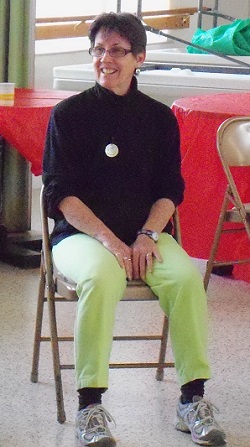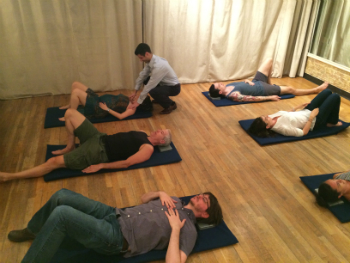 by Brooke Lieb
Meade Andrews will be offering a two-weekend program on the Art of Group Teaching. Teachers and Third Year Trainees can register for one or both weekends. Click here for more information.
by Brooke Lieb
Meade Andrews will be offering a two-weekend program on the Art of Group Teaching. Teachers and Third Year Trainees can register for one or both weekends. Click here for more information.
BL: Tell us a bit about your background and how you first encountered the Alexander Technique:
MA: From the age of 8, I was a devoted student of ballet, hoping to train professionally and become a ballerina. In my first year of college, I began to study modern dance. I sustained a knee injury, which never healed properly, and eventually resulted in an injury to my other knee. I tried modalities such as Rolfing and massage, but did not find healing for my knees. In the early 70's, I attended a theatre conference and watched Ilana Rubenfeld teach an AT class. She is a great teacher, and I saw people moving with ease and whole-body connectedness, and I decided to the study the work. In 1974, I moved to Washington, DC, where there were no AT teachers. However, a group of women were importing an AT teacher from NYC: Rachel Zahn, another pioneer teacher from ACAT. And that's where I began.
BL: Tell us about your training to become an Alexander Teacher?
MA: After I had studied AT for 8 years in DC, with teachers Charlotte Coe, Carol Boggs, and Susan Cohen, I began to study with Marjorie Barstow, who taught in DC twice a year for two weeks. I went to the summer intensives in Lincoln Nebraska where Marj taught for many years. There I met Bruce and Martha Fertman, and when they created a training school, I took their course. When I finished the course, I left my tenured position in the theatre and dance program at American University to become a full-time teacher of the AT. I have been fortunate to have a long and varied career as an AT teacher, traveling throughout the US and abroad: Japan, Spain, Australia, Germany, Switzerland, and England.
BL: How did you develop The Art of Group Teaching?
MA: I first developed my work in the Art of Group Teaching at the Studio Theatre in Washington, DC, in 1989. I was first hired to teach a weekend workshop in the AT for actors. When we sat in a circle, I told them that I was there to introduce them to the AT. In a flash, every single one of them "sat up straight". In that moment, I knew that I would have to develop various group explorations as a means of presenting the work in a meaningful way within a group setting. I knew that I could not work with one person in front of the group, unless we all shared group experiences designed to focus attention and awareness on creating an understanding of the "receptive field", a condition of kinesthetic and cognitive alertness that enlivens and enhances an understanding of the AT principles. Only then, when I could create shared learning experiences and create a learning ensemble, would the students be able to focus their attention knowledgeably while I worked with one student in their presence. We all needed to be on the same page for true learning within a group setting to be accomplished.
BL: What do you enjoy most about offering Post Graduate workshops?
MA: My favorite aspect of teaching Post-Graduate offerings is the opportunity meet teachers from various backgrounds of life study, and AT training. Having studied in group settings and performed in group theatre and dance work for most of my life, I love working with groups of AT teachers and trainees. Meeting and sharing experiences and explorations together, and offering my approach to group teaching, has enriched my professional and personal life immeasurably.
[author] [author_image timthumb='on']http://www.acatnyc.org/main/wp-content/uploads/2014/01/Brooke1web.jpg[/author_image] [author_info]N. BROOKE LIEB, Director of Teacher Certification since 2008, received her certification from ACAT in 1989, joined the faculty in 1992. Brooke has presented to 100s of people at numerous conferences, has taught at C. W. Post College, St. Rose College, Kutztown University, Pace University, The Actors Institute, The National Theatre Conservatory at the Denver Center for the Performing Arts, Dennison University, and Wagner College; and has made presentations for the Hospital for Special Surgery, the Scoliosis Foundation, and the Arthritis Foundation; Mercy College and Touro College, Departments of Physical Therapy; and Northern Westchester Hospital. Brooke maintains a teaching practice in NYC, specializing in working with people dealing with pain, back injuries and scoliosis; and performing artists. www.brookelieb.com[/author_info] [/author]

 by Brooke Lieb
Meade Andrews will be offering a two-weekend program on the Art of Group Teaching. Teachers and Third Year Trainees can register for one or both weekends. Click
by Brooke Lieb
Meade Andrews will be offering a two-weekend program on the Art of Group Teaching. Teachers and Third Year Trainees can register for one or both weekends. Click  by Brooke Lieb
As part of
by Brooke Lieb
As part of 